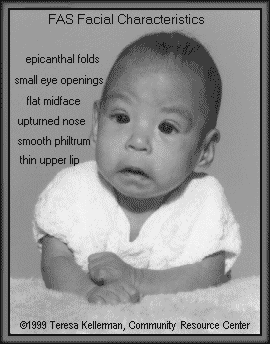
Chemical Dependency: Alcoholism
Center for Contining Dental Education
Notice the facial features on this infant born with FAS.
It is important to note that facial characteristics may not be as apparent immediately after birth, during adolescence or adulthood as they are between the ages of two and ten.

Photo reprinted with permission of Teresa Kellerman,
FAS Community Resource Center
http://www.come-over.to/FASCRC
Other physical features associated with FAS may include:
![]() limitations in joint movement
limitations in joint movement
![]() slow growth, with an unusually slender appearance prior to puberty, including height and weight below the 10th percentile range
slow growth, with an unusually slender appearance prior to puberty, including height and weight below the 10th percentile range
![]() deformities in the small joints of the hand as well as incomplete rotation at the elbow
deformities in the small joints of the hand as well as incomplete rotation at the elbow
![]() vision problems, primarily nearsightedness
vision problems, primarily nearsightedness
![]() auditory problems, primarily inflammation of the ear
auditory problems, primarily inflammation of the ear
![]() shortness of stature
shortness of stature
As the child gets older, however, the physical features associated with FAS become less distinct. This emphasizes the importance of a diagnosis of FAS early in life so assistance can be provided to the child and their family. The behavioral and learning problems associated with FAS do NOT diminish as the child gets older.
Other birth defects, such as congenital heart disease, cleft lip and palate, anomalies of the urinary tract and genitals, and spina bifida occur 5 to 60 times more frequently in children exposed prenatally to alcohol than to the general public.